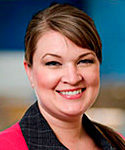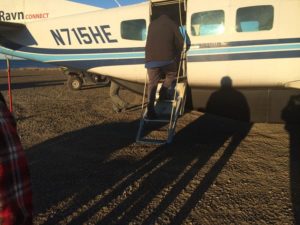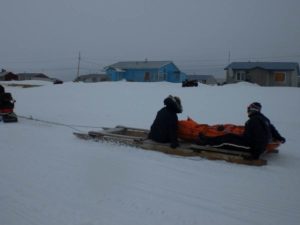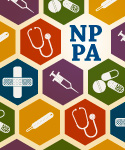January 11th, 2017
On the Front Lines of Regional Medicine
Emily F. Moore, RN, MSN, CPNP-PC, CCRN

Emily F. Moore, RN, MSN, CPNP-PC, CCRN practices pediatric cardiovascular care across the Pacific Northwest.
Being of Alaska Native decent, my desire to practice medicine in Alaska was only natural. However, once I started venturing out into the large geographical region my institution serves, I realized there is nothing scarier than sending a fragile patient home to some of these isolated areas.
A large part of my job is to collaborate with regional providers. With my limited knowledge on the subject, I decided to ask exactly what it’s like to provide regional specialty care to children across a vast area of land.
In speaking with Dr. Jim Christiansen, pediatric cardiologist in Anchorage, I learned a great deal. With only 4857 miles of paved roads in Alaska, access to clinics is typically a combination of many modes of transportation. Think planes, bush planes, boats, and snow machines. His practice, which he shares with one other cardiologist, travels to 11 different practice sites throughout the state. Most of these visits rely on air travel.
Dr. Christiansen says a fair number of his patients rely exclusively on mail-order pharmacies to get their medications, which makes for some creative thinking when weather or other natural phenomena interrupt mail delivery. In fact, there was a time a patient ran out of Coumadin only to be rescued by his school principal who was also taking the medication.
Often times, the choice of surgical procedure (e.g., mechanical vs. bioprosthetic valve) will depend on geographical location and accessibility to appropriate INR monitoring. This proves to be especially challenging when a patient requires Lovenox, as there are only two labs within the state that manage low-molecular-weight heparin levels. In the Bethel census area, there is only one pharmacy serving an area the size of Oregon
 Roughly 70% of Alaska’s physicians reside in only two cities (Anchorage and Fairbanks). In general, subspecialty care is restricted to these locations. Sometimes villages are staffed by a health aide for care. Pediatric specialties are especially limiting — for example, Dr. Matthew Hirschfeld, director of maternal-child medicine at Alaska Native Medical Center, travels to Nome approximately once every other month. Up until about 4 months ago, he was the only pediatrician who traveled to the region. Nome serves as the central hub for 19 surrounding villages. The total population for Nome and these villages is about 10,000, with about 40% being younger than 19 years old.
Roughly 70% of Alaska’s physicians reside in only two cities (Anchorage and Fairbanks). In general, subspecialty care is restricted to these locations. Sometimes villages are staffed by a health aide for care. Pediatric specialties are especially limiting — for example, Dr. Matthew Hirschfeld, director of maternal-child medicine at Alaska Native Medical Center, travels to Nome approximately once every other month. Up until about 4 months ago, he was the only pediatrician who traveled to the region. Nome serves as the central hub for 19 surrounding villages. The total population for Nome and these villages is about 10,000, with about 40% being younger than 19 years old.
Being one of the only pediatricians who travels to Nome, Dr. Hirschfeld and his case manager follow roughly 300-350 kids who either have chronic medical conditions or who have been referred for consultation.
Alaska is not the only state with limited resources. I have worked with areas in central Washington and Montana, informing local hospitals and fire departments of fragile patients. I have gone as far as providing education for each specific patient. As one can imagine, with HIPPA laws being what they are, this gets to be tricky.
 Dr. Jeremy Archer, pediatric cardiologist in Billings, Montana, has similar concerns. Not only is he a cardiologist, he has a master’s degree in health outcomes and policy. So he is quite passionate regarding the topic of Regional Medicine. Dr. Archer has found a calling in creating quality-improvement pathways for fragile patients. He believes the same level of care should be given regardless of patient location. He has created risk-stratification guidelines for his patients and is very open-ended with families when discussing outcomes and location to care. He occasionally advises patients that it would be in their best interest to relocate to bigger cities, despite the financial and social challenges for their families. He feels honesty regarding outcomes is best.
Dr. Jeremy Archer, pediatric cardiologist in Billings, Montana, has similar concerns. Not only is he a cardiologist, he has a master’s degree in health outcomes and policy. So he is quite passionate regarding the topic of Regional Medicine. Dr. Archer has found a calling in creating quality-improvement pathways for fragile patients. He believes the same level of care should be given regardless of patient location. He has created risk-stratification guidelines for his patients and is very open-ended with families when discussing outcomes and location to care. He occasionally advises patients that it would be in their best interest to relocate to bigger cities, despite the financial and social challenges for their families. He feels honesty regarding outcomes is best.
In addition to providing cardiology care to his patients, Dr. Archer assumes the care of gastrostomy tubes and other noncardiac needs. It is often too difficult to find specialty care specific to his patients needs in such areas.
Knowing these limitations, my job is to help patients prepare for discharge with the goal being home disposition. However, some of our patients are so fragile, and live in such distant villages, that we have started to collaborate with local hospitals to transport patients back to the institution they came from. For example, in Anchorage, before sending patients home, we transport them to the Alaska Native Medical Center, which then arranges travel back to their medical hub, where a pediatrician sees them before transport all the way home. Best case scenario: at each phase in these transfers, provider-to-provider communication occurs to formally hand off each patient. The hope of this interaction is to decrease the number of fragile patients discharged without adequate resources, thereby lessening the subsequent bouncebacks to the hospital or even subsequent deaths.
I ask myself, in our ever-changing healthcare system, is it irresponsible to leave these patients in such need? Or is what we are doing — bringing more and more awareness to regional medicine — enough?


Great reflections! Having worked at University of Washington for many years and one training related to HIV and sexually transmitted infections in Alaska, I agree that most physicians in the lower 48 do not necessarily consider these types of barriers–even though these barriers are present in other areas–like my current residence of Alabama. Thank you for thinking through these issues and articulating them here.
Jeanne,
Thank you for your response. Yes, the world of regional medicine is rather fascinating isn’t it? Best of luck to you in Alabama.
Emily
What a great article to read and think about. As I am getting ready to start medical school in the fall, regional medicine is an interest for me. I am from a small town, not as small as the areas in the article, but small, and know even there how difficult and stressful it was getting my sister to a specialist 2.5 hours away. I look forward to learning and thinking on it more.
Tabitha,
Thank you for your response! Best of luck to you as you pursue your career in Medicine.
Emily